How to Rust-Proof Your Axe
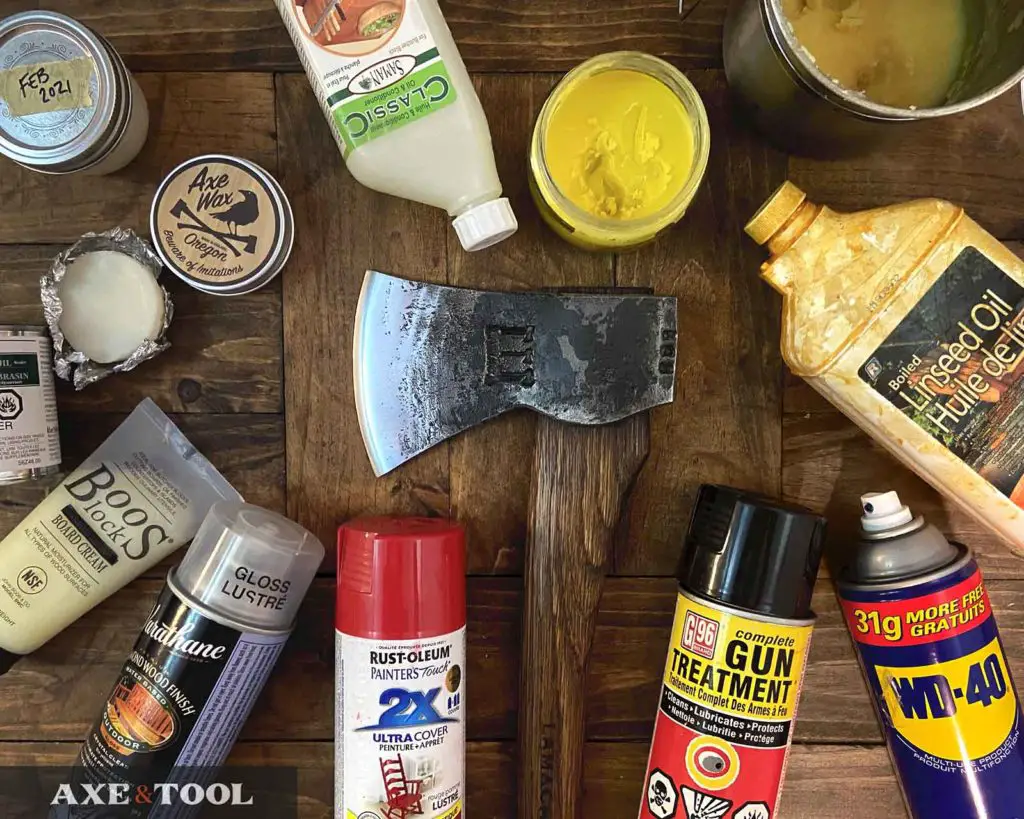
Like it or not, rust is something you are going to have to deal with. An axe head is a large piece of steel that spends a lot of time outside. So here is what to do:
The best way to protect your axe from rust is to clean off any residue after use and apply a light layer of oil or wax to repel moisture. Synthetic, natural, and wood oils can all be used to stop rust, each with unique benefits. Then store your axe indoors where it’s climate-controlled.
The 3 key factors for a rust-free axe are:
- Proper storage
- Regular Cleaning
- Protective coatings
I’m not going to lie, the first two are kinda boring BUT VITAL. But the different coatings are where you can have some fun and find the right solution for your axe.
1. Cleaning your axe
An annoying but effective way of keeping an axe rust-free is cleaning it after each use. It doesn’t take a lot of moisture on the blade to start forming rust spots quickly. Even seasoned firewood can still have a moisture rating of 15-20%
I’ve had an axe rust by just sitting on a recently cut log for a few hours.
A quick spray of oil and a wipe-down with a cloth are usually good enough. But if your axe is really caked in pitch or already rusting it might take a little more elbow grease and maybe some steel wool.
2. Storing your axe

Protective coatings will still not hold up to rust on an axe that’s not stored properly.
The best practice for axe storage is in a dry and climate-controlled room (like in your house).
Direct exposure to moisture is bad, but even temperature and humidity changes can cause condensation that can form rust (temperature changes can also loosen your handle).
Many axes (especially cheaper ones) come with a rubber cover on the bit. Do not store your axe in the rubber cover. It can very easily trap moisture and cause your axe to rust faster. Not having a sheath is actually better than the rubber cover, but a leather sheath is best.
Be careful storing axes in vehicles: I had an axe rust in my trunk (unused), just because of the repeated temperature changes and a rubber blade cover.
3. Protecting your axe with a coating
Once your axe is cleaned, you will still need to add a coating (usually oil) to keep moisture in the air off the metal. This is essential – in some cases, you can get flash rusting almost instantly.
Sprays like WD40 are great for easy axe protection between uses. Drying oils (like boiled linseed oil) or waxes are the best for protecting an axe long term. They take more time to apply but are more durable once hardened. However, there are other portable, food-safe, and semi-permanent options.
This article goes through 14 different ways to stop rust, but my go-to solutions are:
1. WD40 or Gun oil after general use (whichever is closer).
2. Boiled linseed oil or axe wax for long-term protection.
3. Food-safe oil or axe wax for backpacking and bushcraft axes
Quick use sprays
| Quick Sprays | Best Application | Additional Benefits |
| WD40 | General use | Cleans existing rust |
| Gun Oil | General use | Cleans existing rust |
| Ballistol | General use | Cleans and neutralizes acids |
WD40 is great for cleaning and protecting axes
There are a ton of good tool oils that will work. But everyone has WD-40, and it works.
WD-40 is fine for quickly protecting an axe. It will penetrate and help clean away existing rust while leaving a thin fast-drying barrier to prevent corrosion. There is even a specialized WD-40 for maximum rust prevention. However, there are better options for long-term protection.
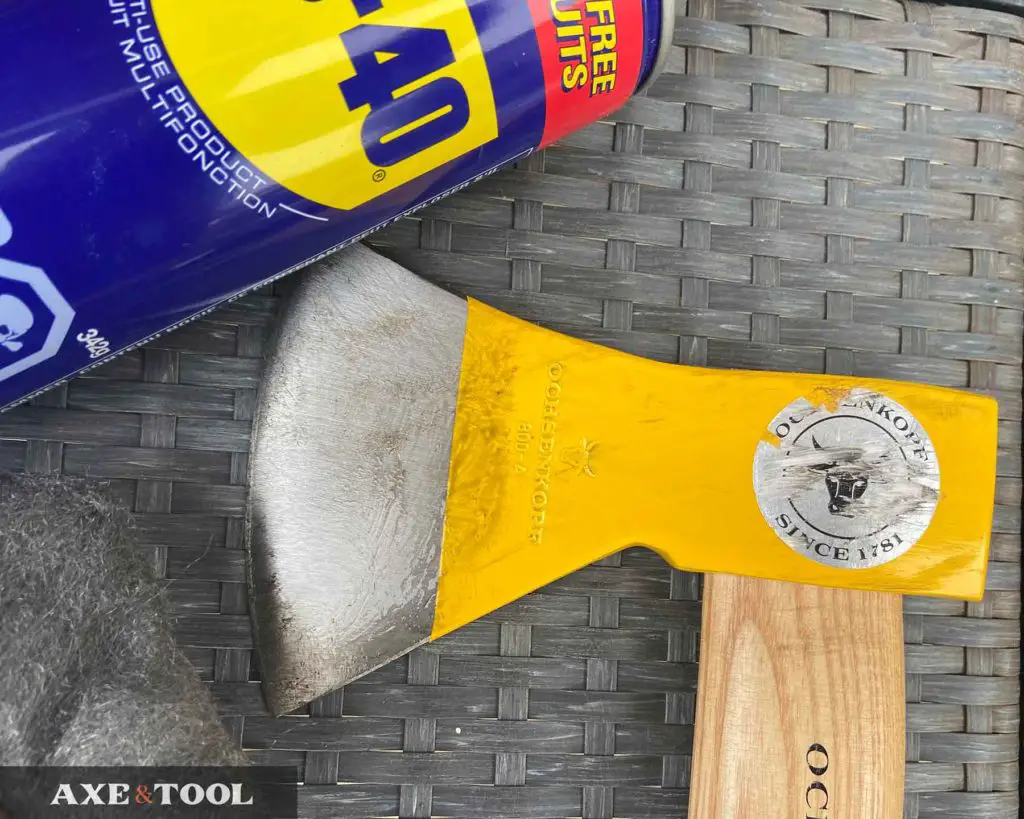
A quick spray or wipe down with a soaked rag will help clean grit and moisture off the blade while providing protection. I would use it within 24 hours of your work, but the sooner the better.
WD40 dries fairly quickly. The carrier fluid will evaporate leaving a thin protective coating everywhere it was able to creep into. Because the remaining coating is so thin, it’s not the greatest rust protection long-term. It’s fairly easy to wipe off – just handling it can affect the protection.
I always spray the WD40 directly on the head, rather than wiping it on. This will help the oil flow into any pitting and scratches. Add a little extra into pitted areas. WD40 is a penetrant, so it’s good at seeping into every little nook and cranny.
For vintage axes I let the oil sit for a couple of minutes to soak in before wiping it down with a rag and putting it in the sheath.
TIP: If you really want it to penetrate deep, do one side at a time. Laying the axe on the ground (oil side up).
For long-term protection:
Give an extra healthy soaking when preparing an axe for longer-term storage, like at the end of a season. Especially if it will be somewhere like a shed, exposed to frequent temperature changes and humidity.
Extra strength option:
Standard WD40 works great, but WD40 Specialist Corrosion Inhibitor (amazon) holds up much longer. I found this last year when I was researching gun oils and it WORKS. I tested it on my trunk axe, which always rusted a little with changing weather. Worked like a charm. Not essential – but I like it.
Gun oils work well on axes
General-purpose and synthetic gun oils are great for quickly protecting an axe as well as cleaning off any existing rust. They are easily applied and leave a thin protective layer of oil that will quickly dry to the touch. However, there are better options for long-term protection.
There are lots of different types of gun oil, but they all work to clean, protect, and/or lubricate. For axes, we can ignore the heavy lubricants and gun greases and focus on the spray cans to cover more surface area.
I use a basic synthetic spray (G96 brand). It does the job (and smells great). It’s similar to Hoppe’s or Rem oil. Don’t go out of your way to buy this brand, it’s just what I use out of habit. Use whatever you have.
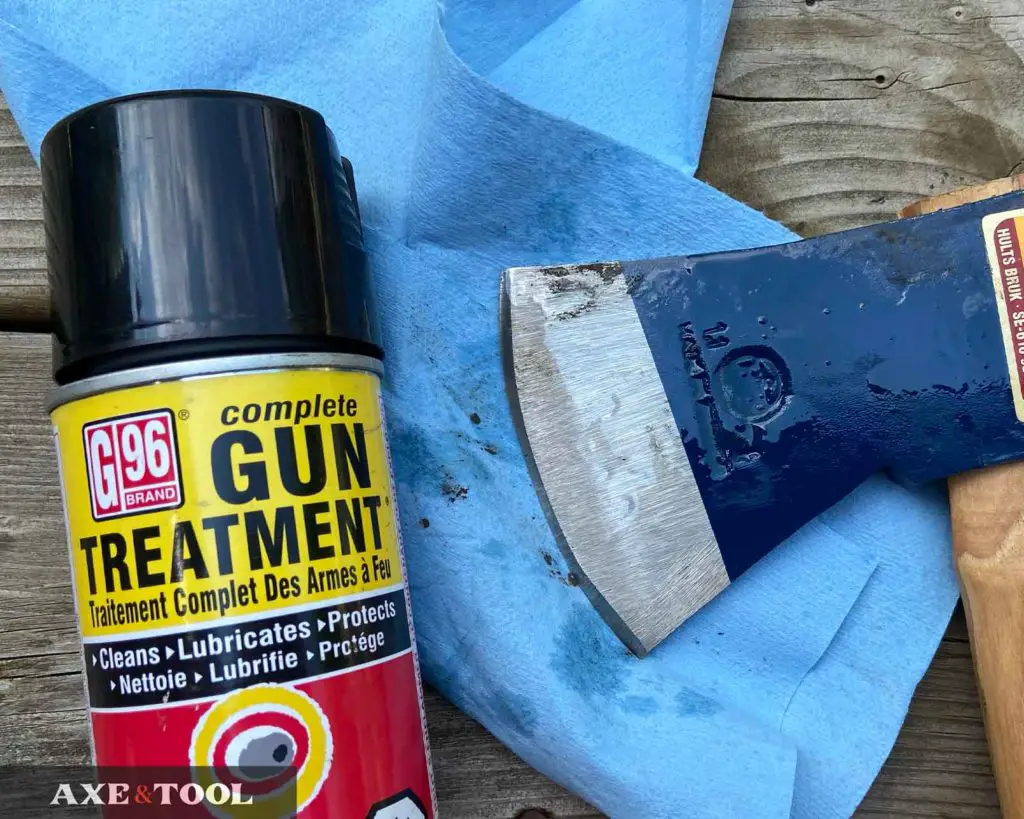
Apply gun oil just like WD40. I feel better about getting gun oil on the wood handle than WD40, but I still try and avoid it. I don’t want them to interfere with any new coats of boiled linseed oil (although I’m sure it’s totally fine).
Hoppes Elite gun oil is one of the best rust-preventing gun oils based on testing of 46 different oils on steel (source). But it’s not a spray-on (If that matters to you).
Ballistol is a long-time favorite
Ballistol is a great multipurpose spray that is perfect for axes. You apply it much like WD-40 or gun oil but it has unique benefits to axe protection.
What makes it unique is that it actually neutralizes the acid from your skin oils and sweat, whereas other oils just act as a barrier. It won’t dry out, and it’s good for leather and wood too. Which is super convenient for an axe. It’s also eco-friendly, skin safe, and while not “food safe”, they say it “does not contain ingredients considered hazardous by the FDA” (so make of that what you will).
It has a kind of licorice smell – not everyone’s favorite. But it disappears pretty quickly.
If you are going out of your way to buy a spray – this might be the one to get (see on Amazon).
Drying oils & Axe wax
| Drying Oils & Waxes | Best Application | Additional Benefits |
| Boiled Linseed Oil | Long term protection | Good for handles |
| Axe Wax | General use or long term | Packable, handle use, food safe* |
* Not all axe waxes are food-safe
Boiled linseed oil is not just for axe handles
This was my go-to for long-term storage for a long time before I started making my own waxes. It’s dead easy to apply and creates a very strong finish.
If you have a wood-handled axe, boiled linseed oil is essential. It’s pretty cheap on Amazon, and the brand doesn’t really matter. If you have not oiled the handle either, see my article on how to create the best finish here.
Any drying wood oil will work, but Boiled linseed oil (BLO) is the standard go-to for handles. I use it for the entire axe during restorations or during seasonal maintenance. Either before axe wax or just on its own.
Any time you oil your handle, add a thin coat of boiled linseed oil to the (clean) axe head, wiping away excess. Allow 12-24 hours to dry and it will harden into a shiny protective clear coat. Boiled linseed oil has additives to make it dry quickly but it will still take longer on steel than wood.
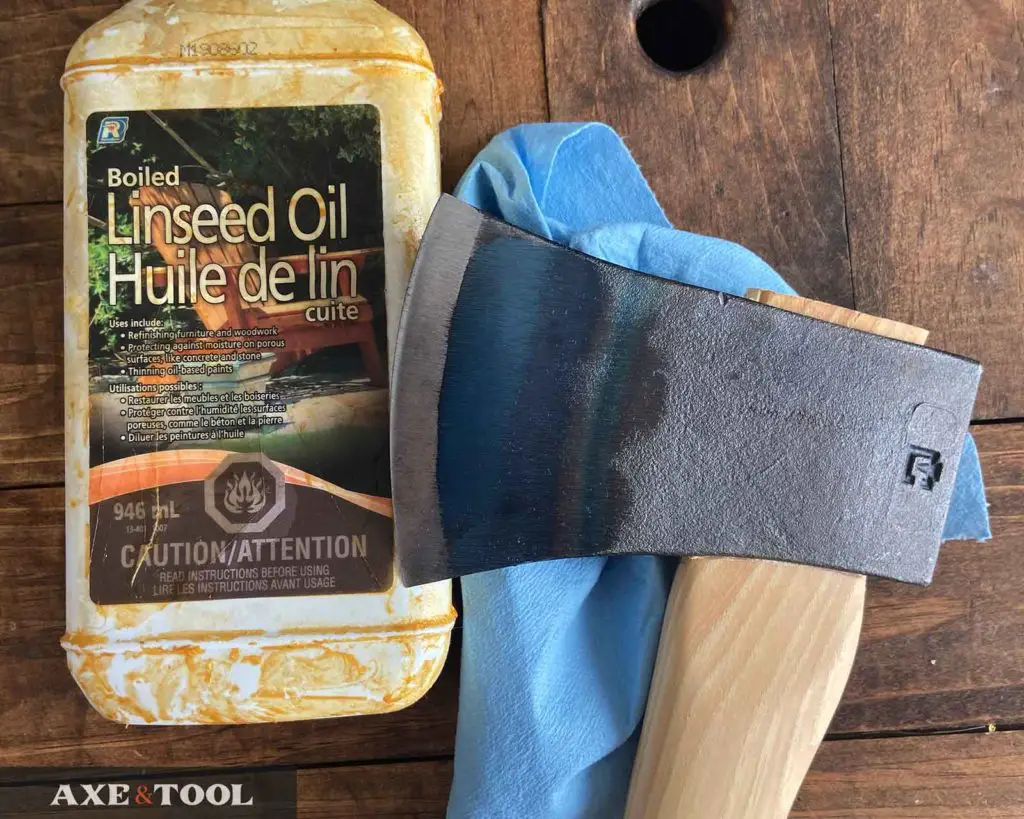
It’s a little too inconvenient to bother with for quick cleaning or oiling, but it’s perfect for a longer-term coating. I’ve seen it referred to as a “redneck clear coat”. When you are doing end-of-year cleaning on your axe, and giving the handle a coat of BLO, take the opportunity to do the head as well.
While it’s not as thick as a wax (up next), I like this coating for storage because it is more durable than typical oil and it’s easy to apply at the same time as you are oiling your handle. There are chemical drying agents in BLO, so it is not food-safe.
This same approach can be done with other hardening wood oils as well. And some (like Danish oil) can even be food-safe.
TIP: I would not use this on a highly polished axe you want to display as a showpiece. The BLO will leave residue smudging and clouding the polish. Since these axes are likely indoors just stick to a WD40 or gun oil.
Axe wax is compact, portable, and protects the whole axe
Axe wax is a mixture of wax and oil that can be used to treat all parts of an axe. The oil protects metal and rejuvenates wood, while the wax hardens to protect and seal in the oil. Food-safe and non-food-safe waxes can be purchased or easily made yourself.
Axe wax goes on much thicker than oil, and it hardens which is a big advantage. This leaves a more robust barrier on the metal that can withstand light surface contact. Lighter oils may be rubbed off or absorbed by the sheath leaving the metal exposed to rust. I get more peace of mind with a stronger wax when storing an axe for months at a time. But even though it’s “hardened” it’s not going to last on the head after any real chopping.
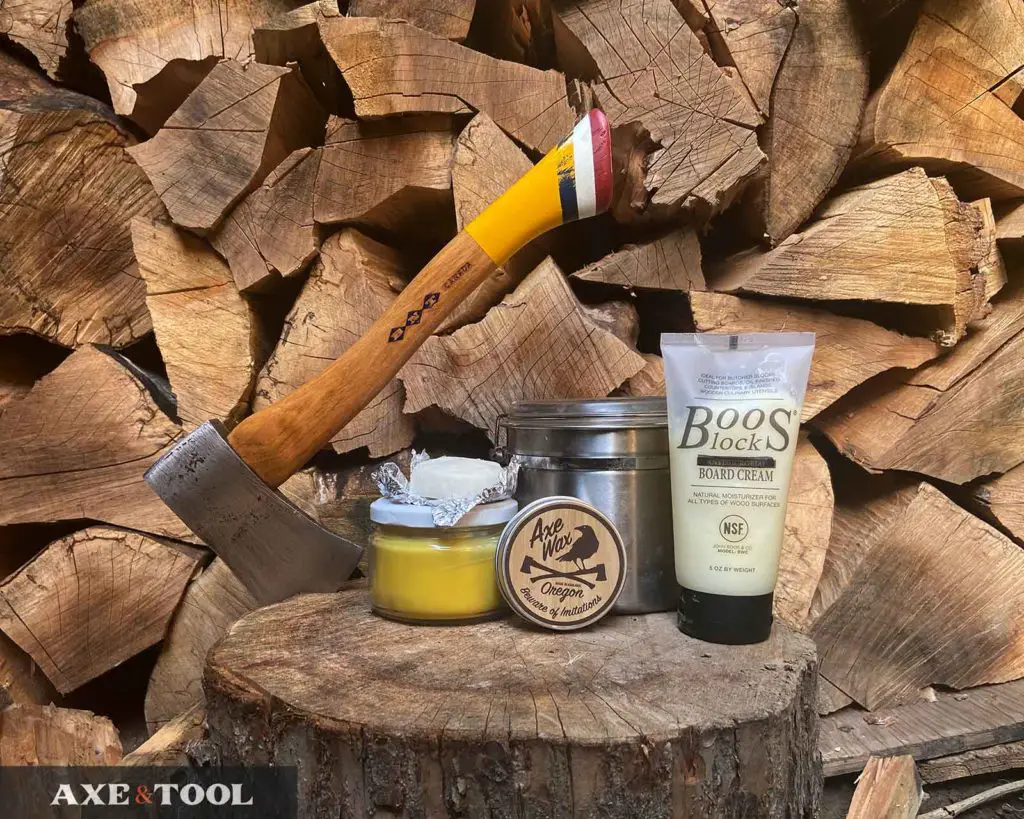
Axe wax is also easy for bushcraft or backpacking axes because it can be food-safe, light to carry, and solid so you don’t have to worry about spills. It can also be used for the other tools you carry with you – but it doesn’t help clean.
For store-bought wax, the crowd favorite is simply called Axe Wax and is made in Oregon. It’s food-safe and good to use on the handle, head, sheath, you name it. It’s about $20 for a 2oz can, and is worth it.
TIP: If you leave your axe and hard wax in the Sun to warm up it will go on much easier. Or in cold weather, you can warm a CLEAN cloth in the oven for a few minutes to help rub it in.
Make your own wax
Most axe waxes are meant for both the head and handle – and are a little softer. I recommend making your own, which will allow you to make harder mixtures for the head. Generally, a harder wax is best for metal and is tougher to rub off (but it’s also tougher to rub in).
I have 3 recipes for axe wax, one is extra hard for the toughest metal protection. They are easy, fun, a fraction of the cost (like 1/10 the cost per oz), and can be used on other tools and knives.
A cheaper axe wax
Here is a little cost-saving tip for anyone who just wants to buy wax. Butcher block or cutting board wax is basically the same thing and is usually about $20 for 5-9 oz. So that’s about ¼ the price of the axe wax brands. Plus you’ll have extra for the kitchen.
I’ve used Howards before, it’s a little softer but it works well (amazon)
Specialty coatings for axe heads
| Specialty Coatings | Best Application | Additional Benefits |
| Fat or Lard | Homestead | Dissolves pitch/sap |
| Food Safe Oils | Bushcraft Axes | Food safe |
| Kitchen Oils | Not recommended | Everyone has them |
| Vaseline | Backpacking | Common pack item already |
Fat or lard can stop rust and clean pitch off your axe
Yes, you read that correctly – Fat. Fat will not just protect, but it will clean your axe!
I learned this method from the Youtuber SkillCult (a great channel) for cleaning pitch off an axe. Pine pitch (that thicker, stickier sap) is a complete pain in the ass to get off of anything, but surprisingly it is fat-soluble.
All you need to do is coat the axe head in a bit of fat and put it away. The fat will keep moisture off the metal while slowly breaking down any sticky pitch. Next time you use the axe just wipe off the fat, and the pitch will come with it. So fat will protect and clean your axe at the same time.

I went out of my way to try this out – not in my usual rotation. Axe now smells faintly of bacon.
This technique is very cool, but it’s certainly not for every occasion. I don’t store any of my axes with fat. I don’t want to forget which axe has fat on it and not use it for 8 months – that could get gross. But I keep a small jar for when it’s needed. This would be great for a regular work axe on a homestead or cottage that gets frequent use with sticky softwood trees.
How do you get the fat?
The fat from a single pack of bacon fills a small mason jar quite nicely.
That’s all I need at one time ( any reason to cook more bacon). Just make sure you strain out any bacon bits that could go rancid quickly (I just use a coffee filter) and store it in an airtight jar. Properly strained and stored fat will keep for 6 months on the shelf.
TIP: Date your containers to avoid a nasty surprise.
Food oils (like olive oil) should also work, but they are too runny to pile on thick and stay in place.
Food Safe oils for bushcraft and backpacking
If you are using an axe for hunting or food prep you should be using a food-safe oil to avoid contamination. I don’t want to eat anything laced with WD-40 or boiled linseed oil (which contains petrochemicals and metal-based dryers).
There are a few wood and tool oils that are food-safe like raw linseed oil, tung oil, Danish oil, and food-safe mineral oil. These can be used on the entire axe to protect both the head and handle.
Warning: check the oil you buy carefully, different producers may use different techniques. And oil finishes often have additional additives that may be harmful.
I would use this more for routine maintenance and care, rather than in-field use. Since these oils don’t have additives they won’t truly harden and can take a longer time to dry, making it too much hassle to bring into the woods. I use a food-safe wax in the field.
Raw linseed oil & hardening wood oils
Raw linseed oil can be tough to find in big stores, but it also goes by the name “Flaxseed Oil” in the kitchen. So it’s easy enough to find if you know what you are looking for.
Be very careful looking for a food-safe wood finish. There are many “oil finishes” that also contain chemicals but have similar names. If you aren’t sure – assume it’s not.
Food Safe Mineral Oil
Food-safe mineral oil is a great food-safe option for an axe. It’s widely used for kitchen knives and cutting boards and will clean and protect axe heads and moisturize handles. It is odorless, tasteless, won’t spoil, and can be used on its own or with wax for a more durable finish.
I like the mineral oil more than other oils in this list because I find it helps clean the axe better as well. That is just from experience – I have nothing scientific to back that up.
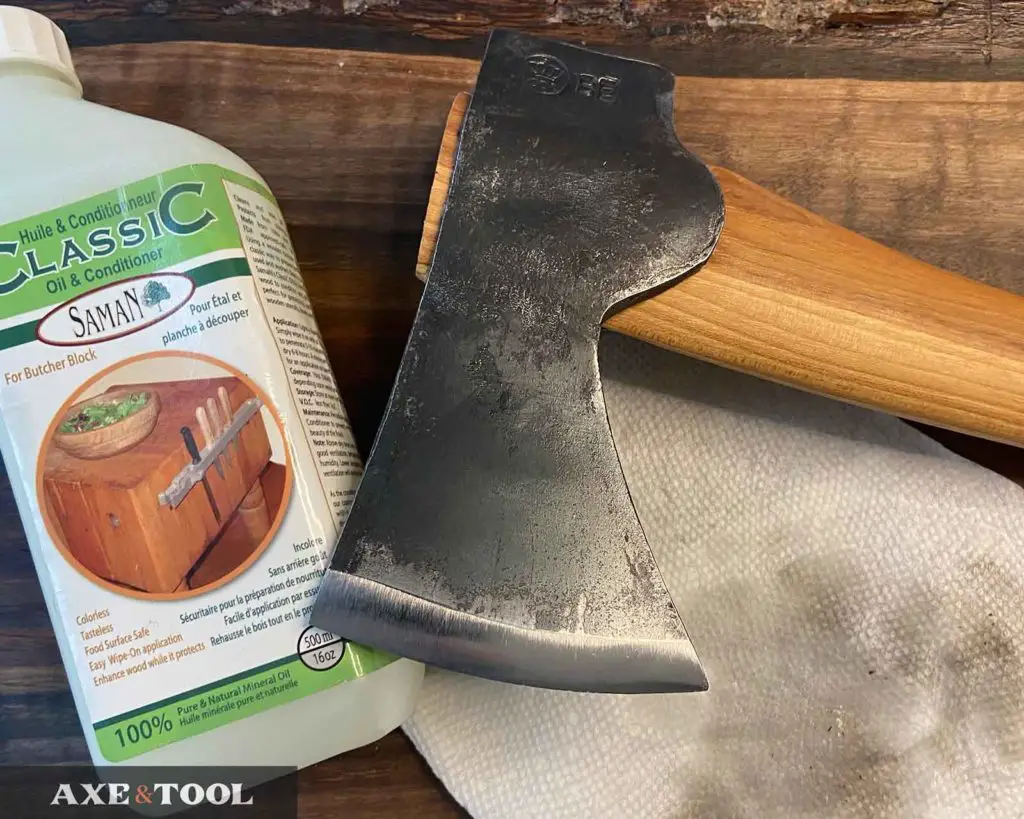
Be sure to get FOOD SAFE mineral oil and not standard mineral oil from a hardware store. The easiest way to find it is as a cutting board or butcher block oil, which you can order from Amazon, but it can also be found at pharmacies (for babies). The brand doesn’t matter, as long as it’s 100% food safe.
Like the wax – you can use the extra around the house (amazon).
TIP: Pharmacy oil will likely be cheaper than butcher block oil, but they are the same thing. Farm supply stores often sell food-grade mineral oil for animal care by the gallon for very cheap if you want a lot.
Some people don’t like food-safe mineral oil because it is still a petroleum product, so you can also get coconut-based cutting board oils that work the same way but are all-natural.
Can you use olive oil and kitchen oils on an axe?
Olive or vegetable oils can be used on an axe, but are generally not recommended. Unlike tool oils, they can spoil and go rancid and do not harden or dry. However, flaxseed oil is also called raw linseed oil and is commonly used as a slow-drying wood oil.
A thin coat on an axe head won’t be an issue in a pinch, but probably shouldn’t be used long-term. It COULD build up inside a leather sheath and ruin it if the oil does spoil.
However – some people say they use olive oil all the time and have never experienced the oil going bad, and raw linseed oil is commonly used (and can also go rancid), so I’m not convinced this is an issue. But why take the chance when there are so many better options out there? So yes they work and are obviously food safe but I don’t use them.
Vaseline for backpacking axes
If you have decided it’s worth the weight to carry an axe while backpacking (which I often don’t), you can save yourself a couple of ounces by not bringing additional oil.
Vaseline is one of the best oils for axe and tool protection while backpacking because you are likely already packing it. It’s good for first aid, blister prevention, fire starting, and rust prevention. Don’t add weight to your pack with another oil for your axe unless you plan on using it for food prep or hunting.
Vaseline goes on thick and will keep the moisture out completely. You can wipe it down to a thin layer, but it stays wet so consider that when packing your axe. Some people use it for treating and waterproofing leather, so it could work well for your backpacking axe and sheath at the same time.
It is a petroleum product and should not be used on your axe if you plan on using it for food prep.
Semi-Permanent Axe Protection
| Semi-Permanent | Best Application | Additional Benefits |
| Paint | Hard-working axes | Fills pitting, longest-lasting |
| Clear Coat | Display axes* | Only apply once |
| Patina | Leave existing | Works with other options |
| Cold Blue | Minimal protection | Appearance |
* Do not use on highly polished surfaces – it will show
Painting an axe head

Paint is a truly hard protective barrier. Everything before this point is likely going to need to be reapplied after one good chop.
Paint WILL wear off with use, it lasts much longer than oil or wax and is as close to “permanent” as you are going to get.
Paint is certainly not required on an axe head (I don’t paint most of mine), but it does offer some unique advantages:
- Fills in pitting and low areas with a barrier that won’t come off, permanently preventing rust in hard-to-clean areas
- You can see where the paint has worn off and know what areas need additional attention
- If you pick a bright color it helps you see the axe and be aware of the sharp end. It can be easy to lose an axe in the forest.
NOTE: Harder enamel paint from the manufacturer is going to last longer than paint you apply yourself, but your standard Rustoleum will do just fine.
We have an article on the right way to paint your axe head here.
Clear coat or varnish on axe heads
Very similar to paint, except (you guessed it) clear! The advantage is that you can keep the “natural” look of your axe, while it’s completely sealed up from moisture.
Personally, I don’t use it anymore, as it will gum up sharpening tools and get streaky and ugly after as little as one chop. But it could work for a display piece.
Varnish or clear lacquer will add a sheen to the metal and there are subtle inconsistencies and drops in the spray that will stand out on polished metal.
Patina adds natural protection
If you are restoring an old rusted axe you can clean it up while keeping the existing patina to act as a protective layer on the outside of steel. Patina acts as a shield as the outer layer of the steel is already oxidized (rusted), preventing new corrosive rust from easily forming.
If you have already cleaned the rust off your axe head, there are actually ways to add your own patina. They will not do a lot to protect and are mostly just for looks. But they help a little.
Forced patina should only be added to axe heads that have not yet been hung. So if you are starting a new project, plan what kind of finish you want.

The vinegar patina is the darker grey area on the left axe, the right one is cold-blued.
Cold Blue doesn’t add much protection
Cold blue sometimes gets listed as rust prevention – and it does A LITTLE. However, I don’t think it is worth considering as a primary tool for the job. It’s really about aesthetics. And if you do get your axe rusty, that blueing is coming off with the steel wool or sandpaper.
Please comment below If I missed something or if you have any questions. I do my best to respond to everyone.
About the author:
About the author:
Jim Bell | Site Creator
I’m just a guy who likes axes. I got tired of only finding crap websites, so I set out to build a better one myself.
I’m also on Instagram: @axeandtool



Jimbo –
enjoyed your article as I was looking around for info on restoring old and crappy axe heads.
thanks and keep up the good work with your site!
john
billerica, ma
Appreciate it! Have fun restoring – it’s an addictive hobby. I’m hoping to put out a start to finish restoration guide in the next month or so.
Hi Jim,
Would you (have you?) ever seasoned the axe head after the metal is throughly expose, say after a reprofiling?
Despite many coats of (singer sewing machine) oil, and storing it in a stable and dry place, I find the head I reprofiled keeps on developing surface rust… I’m considering treating it as I do with my cast iron cookware – gently heating in the oven for an hour or so at about 200°C while coated in oil, kinda creates a patina of sorts… then handle it and carry on with normal maintenance as you posted here.
What’s your view on this?
Cheers,
Paulo
My hunch is that the Singer oil might be too thin, since it’s for such fine moving parts (although I have never used it). So, you may just want to try a different type of oil.
As for “seasoning” it – I have never tried it on an axe. I would be a little worried that heating the axe would mess with the temper of the edge, but 200 seems low enough – so it might be okay. If you give it a shot, please let me know how it goes.
I use singer oil for all my woodworking tools and more – it performs well on new/reconditioned cast iron, tool steel, you name it. Same as 3-in-1 or (poured) WD40. My guess is same viscosity
I got restless yesterday 😜 and stuck a handle to it.
Alas, seasoning in the oven will remain ‘a thought for another head’
Thanks for your input, I will report back if I ever do it. Cheers